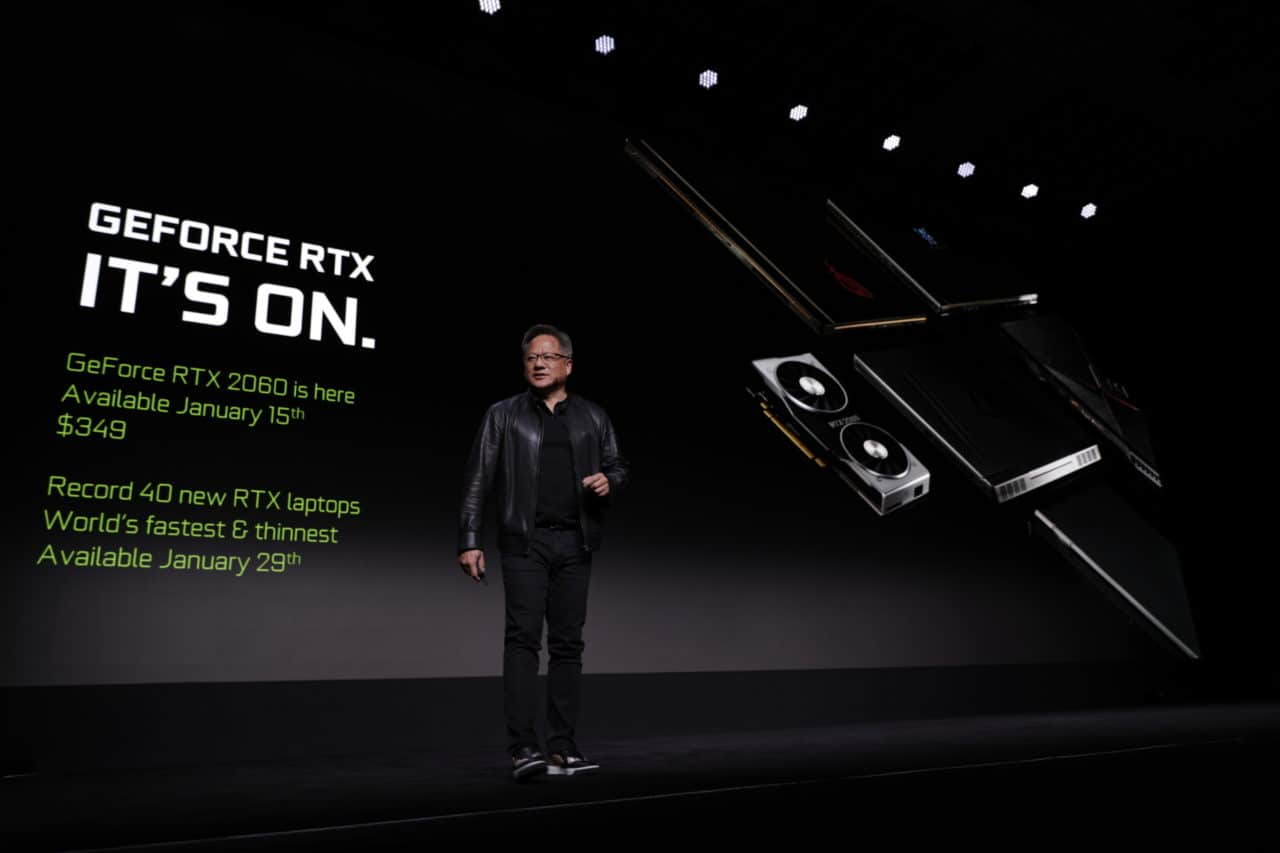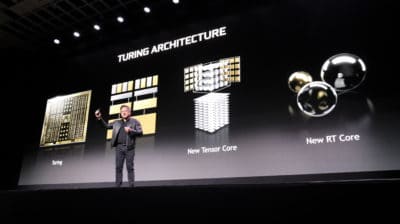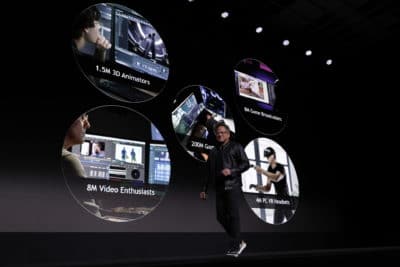NVIDIA kicked off CES 2019 on Sunday night by outlining sweeping plans to put to work the radical new graphics technology of real-time ray tracing in gaming and content creation in a dizzying array of laptops and desktops.
Speaking to a crowd of nearly a thousand attendees, NVIDIA CEO Jensen Huang announced the GeForce RTX 2060, which at $349 makes NVIDIA’s new Turing architecture accessible to tens of millions of PC gamers.
“RTX is here, next gen is on,” said Huang, speaking to a packed house of press, partners and professionals from around the consumer electronics and automotive industries at the MGM Grand in Las Vegas.
Huang’s unveiling of the RTX 2060 was the highlight of a flurry of announcements, including more than 40 new laptop models in 100+ configurations based on new Turing-generation GPUs, and new monitors packed with NVIDIA G-SYNC technology for silky smooth gaming.
“For $349 you can enjoy next generation gaming,” Huang said to broad hoots from the audience. “The long awaited RTX 2060 is here.”
Stunning Demos
Kicking off a 90-minute talk studded with stunning demos, Huang explained how Turing represents the biggest shift in real-time graphics since NVIDIA invented the programmable shader more than 15 years ago.
Turing combines support for real-time ray tracing — thanks to its RT Cores — and deep learning — thanks to its Tensor Cores — in addition to a new generation of programmable shaders.
“It learns from great content what it should look like,” he said. “Then, one day, we give it an image and it goes through a network called DLSS and what comes out of it is a beautiful image. This is the neural network we created to improve an image.”
The combination reinvents graphics, allowing designers, artists and developers to create photo-realistic experiences that were only possible in scenes painstakingly generated over days, or weeks, on sprawling render farms.
The approach received immediate industry support from Microsoft, the companies that offer the most widely used game engines, and some of the world’s biggest game developers.
Huang then segued to a stunning demo that’s sure to go viral. Those who have tuned into any of NVIDIA’s recent events know the first part of the tale: a futuristic hero is equipped with armor, with the whole thing rendered in stunning detail, thanks to real-time ray tracing.
This demo, though, has a twist. Our hero launches himself into the sky, before sticking a suitably heroic landing. And then he gets stuck. The takeaway: real-time ray tracing makes real-time cinematic graphics possible.
It was the first of a cavalcade of demos with a single message: RTX has ushered in a new generation of gaming, with truly cinematic graphics. In addition, new benchmarks, such as 3DMark Port Royal, make it easier to measure the combined impact of RTX’s new features on gaming experiences.
Another showstopper: Anthem, available Feb. 15, a fast-paced game set in a sprawling open world from BioWare, the acclaimed Canadian studio behind the Dragon Age and Mass Effect franchises.
All of these experiences will be more accessible than ever, thanks to the new GeForce RTX 2060. The new graphics card is the ideal upgrade, as games get more demanding and look to trade up to the latest generation of graphics technology, Huang said.
NVIDIA also continues to push forward the state of the art for gaming displays. Launched in 2013, G-SYNC introduced gamers to smooth variable refresh rate gameplay, with no screen tearing and no V-Sync input lag.
Huang announced plans to bring NVIDIA’s expertise with display technology to the broader pool of adaptive sync displays, announcing 12 G-SYNC Compatible displays and bringing silky smooth and beautiful gameplay to more gamers.
Real-Time Ray Tracing on a Laptop
These advancements are supported by a host of new systems from major PC brands featuring GeForce RTX. Gamers can also dip into a range of new thin-and-light laptops featuring Geforce RTX 2080, RTX 2070 and RTX 2060 GPUs. Huang announced a record number of laptops from all the top brands, many of them thin-and-models featuring NVIDIA’s Max-Q design.
These systems make it possible for gamers to enjoy the latest ray-tracing enhanced games — such as Battlefield V — while playing on battery power.
“We’ve redefined mobile gaming,” he said, holding a sleek new notebook on which he played Battlefield V. “This is twice as fast as Playstation Pro.”
And content creators will be able to free themselves from bulky workstations, rendering animations and editing high-definition video content on the go.
There are 8 million people who broadcast games, many using OBS, the world standard for coding and streaming. And there are many who use VR. And content creation, too.
As a result, Huang announced that RTX will be able to use Autodesk Arnold for interactive rendering. RTX will be able to be used to do 8K RED video editing.
And we’re partners with OBS on pro-quality broadcast streaming on a single PC, rather than the two that are currently required. RTX can also be used for high-end VR — with VirtualLink — a single wire that connects the GPU to the head mounted display — and other features with HTC, which the company will announce later at CES.
All this is “so we could create the perfect GPU for gamers, rather than just the perfect gaming GPU,” Huang said.


